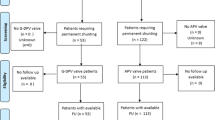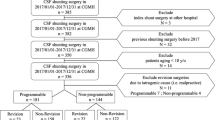Abstract
Purpose
We report five rare cases of programmable valve breakage (Codman Hakim-Medos valve) in shunt systems of children with posthemorrhagic hydrocephalus. Only four similar studies have been published in the current literature.
Methods
Between 2013 and 2018, five children with posthemorrhagic hydrocephalus were admitted to the pediatric department. All patients had a history of slight blows to the head in a minor trauma and follow up MRI scans. After initial clinical examination, cranial computed tomography (CT) and X-ray were conducted.
Results
In all cases, pumping the reservoir resulted in very slow refilling. The cranial CT in one patient showed slit ventricles confirming the suspicion of overdrainage, the other cases a slight enhancement of the hydrocephalus. In lateral X-rays of the skull in comparison to the first X-ray control of the shunt valve, the pressure control chamber could be seen dislocated in the inferior part of the reservoir in all cases. Surgery revealed that the shunt valve was broken. The pressure control chamber had dropped to the bottom of the reservoir. After implantation of a new shunt valve, the symptoms resolved completely in all five children. Overall this complication occurred in 4.3% (5 of 85 implanted Codman Hakim-Medos valve) of all children necessitating ventriculoperitoneal shunt implantation between January 2013 and December 2018.
Conclusion
The well-accepted Codman Hakim-Medos programmable valve is part of a tube-system, which is designed to offer the possibility of a reliable and precise treatment of hydrocephalus. Various mechanical and non-mechanical complications of shunt systems have been reported. Valve breakage is a very rare condition, often missed, and must be kept in mind when trauma and prior MRI scan are reported.


Similar content being viewed by others
References
Drake JM, Kestle JR, Tuli S (2000) CSF shunts 50 years on--past, present and future. Childs Nerv Syst ChNS Off J Int Soc Pediatr Neurosurg 16:800–804. https://doi.org/10.1007/s003810000351
McGovern RA, Kelly KM, Chan AK et al (2014) Should ventriculoatrial shunting be the procedure of choice for normal-pressure hydrocephalus? J Neurosurg 120:1458–1464. https://doi.org/10.3171/2014.1.JNS131808
Ray P, Jallo GI, Kim RYH et al (2005) Endoscopic third ventriculostomy for tumor-related hydrocephalus in a pediatric population. Neurosurg Focus 19:E8
Wong T-T, Chen H-H, Liang M-L et al (2011) Neuroendoscopy in the management of pineal tumors. Childs Nerv Syst ChNS Off J Int Soc Pediatr Neurosurg 27:949–959. https://doi.org/10.1007/s00381-010-1325-5
Buchanan CC, Hernandez EA, Anderson JM, Dye JA, Leung M, Buxey F, Bergsneider M, Afsar-Manesh N, Pouratian N, Martin NA (2014) Analysis of 30-day readmissions among neurosurgical patients: surgical complication avoidance as key to quality improvement. J Neurosurg 121:170–175. https://doi.org/10.3171/2014.4.JNS13944
Vinchon M, Rekate H, Kulkarni AV (2012) Pediatric hydrocephalus outcomes: a review. Fluids Barriers CNS 9:18. https://doi.org/10.1186/2045-8118-9-18
Reddy GK, Bollam P, Caldito G (2014) Long-term outcomes of ventriculoperitoneal shunt surgery in patients with hydrocephalus. World Neurosurg 81:404–410. https://doi.org/10.1016/j.wneu.2013.01.096
Kestle J, Drake J, Milner R et al (2000) Long-term follow-up data from the shunt design trial. Pediatr Neurosurg 33:230–236. https://doi.org/10.1159/000055960
Cochrane DD, Kestle J (2002) Ventricular shunting for hydrocephalus in children: patients, procedures, surgeons and institutions in English Canada, 1989-2001. Eur J Pediatr Surg Off J Austrian Assoc Pediatr Surg Al Z Kinderchir 12(Suppl 1):S6–S11. https://doi.org/10.1055/s-2002-36864
Okazaki T, Oki S, Migita K, Kurisu K (2005) A rare case of shunt malfunction attributable to a broken Codman-Hakim programmable shunt valve after a blow to the head. Pediatr Neurosurg 41:241–243. https://doi.org/10.1159/000087481
Sato K, Shimizu S, Utsuki S et al (2006) Disparity between adjusted and actual opening cerebrospinal fluid pressure in a patient with the Codman Hakim programmable valve: occult form of shunt failure due to head banging. Case report J Neurosurg 105:425–427. https://doi.org/10.3171/ped.2006.105.5.425
Mauer UM, Kunz U (2011) More malfunctioning Medos Hakim programmable valves: cause for concern? J Neurosurg 115:1047–1052. https://doi.org/10.3171/2011.5.JNS101396
Shimizu S, Utsuki S, Suzuki S, Oka H, Fujii K (2005) Obstruction of a Codman-Hakim programmable valve by a migrating pressure control cam. J Neurosurg 103:270–271. https://doi.org/10.3171/ped.2005.103.3.0270
Stone JJ, Walker CT, Jacobson M et al (2013) Revision rate of pediatric ventriculoperitoneal shunts after 15 years. J Neurosurg Pediatr 11:15–19. https://doi.org/10.3171/2012.9.PEDS1298
Gardner P, Leipzig T, Phillips P (1985) Infections of central nervous system shunts. Med Clin North Am 69:297–314
Joseph H, Piatt J (1995) Cerebrospinal fluid shunt failure: late is different from early. Pediatr Neurosurg 23:133–139. https://doi.org/10.1159/000120950
Schoenbaum SC, Gardner P, Shillito J (1975) Infections of cerebrospinal fluid shunts: epidemiology, clinical manifestations, and therapy. J Infect Dis 131:543–552
McGirt MJ, Zaas A, Fuchs HE et al (2003) Risk factors for pediatric ventriculoperitoneal shunt infection and predictors of infectious pathogens. Clin Infect Dis 36:858–862. https://doi.org/10.1086/368191
Drake J, Sainte-Rose C The shunt book. Blackwell science, Cambridge, Mass
Tuli S, Drake J, Lawless J et al (2000) Risk factors for repeated cerebrospinal shunt failures in pediatric patients with hydrocephalus. J Neurosurg 92:31–38. https://doi.org/10.3171/jns.2000.92.1.0031
Piatt JH, Carlson CV (1993) A search for determinants of cerebrospinal fluid shunt survival: retrospective analysis of a 14-year institutional experience. Pediatr Neurosurg 19:233–241; discussion 242. https://doi.org/10.1159/000120738
Black PM, Hakim R, Bailey NO (1994) The use of the Codman-Medos programmable Hakim valve in the management of patients with hydrocephalus: illustrative cases. Neurosurgery 34:1110–1113
Reinprecht A, Dietrich W, Bertalanffy A, Czech T (1997) The Medos Hakim programmable valve in the treatment of pediatric hydrocephalus. Childs Nerv Syst ChNS Off J Int Soc Pediatr Neurosurg 13:588–593; discussion 593–594. https://doi.org/10.1007/s003810050145
Hakim CA (1985) The physics and physicopathology of the hydraulic complex of the central nervous system (the mechanics of hydrocephalus and normal pressure hydrocephalus). Thesis, Massachusetts Institute of Technology
Zemack G, Romner B (2000) Seven years of clinical experience with the programmable Codman Hakim valve: a retrospective study of 583 patients. J Neurosurg 92:941–948. https://doi.org/10.3171/jns.2000.92.6.0941
Author information
Authors and Affiliations
Corresponding author
Ethics declarations
Conflict of interest
The authors have no conflict of interest.
Ethical approval
This article does not contain any studies with human participants or animals performed by any of the authors.
Additional information
Publisher’s note
Springer Nature remains neutral with regard to jurisdictional claims in published maps and institutional affiliations.
Rights and permissions
About this article
Cite this article
Schwarm, F.P., Nagl, J., Bender, M. et al. Programmable valve breakage in shunt systems of children with posthemorrhagic hydrocephalus after minor head trauma—a case series. Childs Nerv Syst 36, 2027–2031 (2020). https://doi.org/10.1007/s00381-020-04541-6
Received:
Accepted:
Published:
Issue Date:
DOI: https://doi.org/10.1007/s00381-020-04541-6




